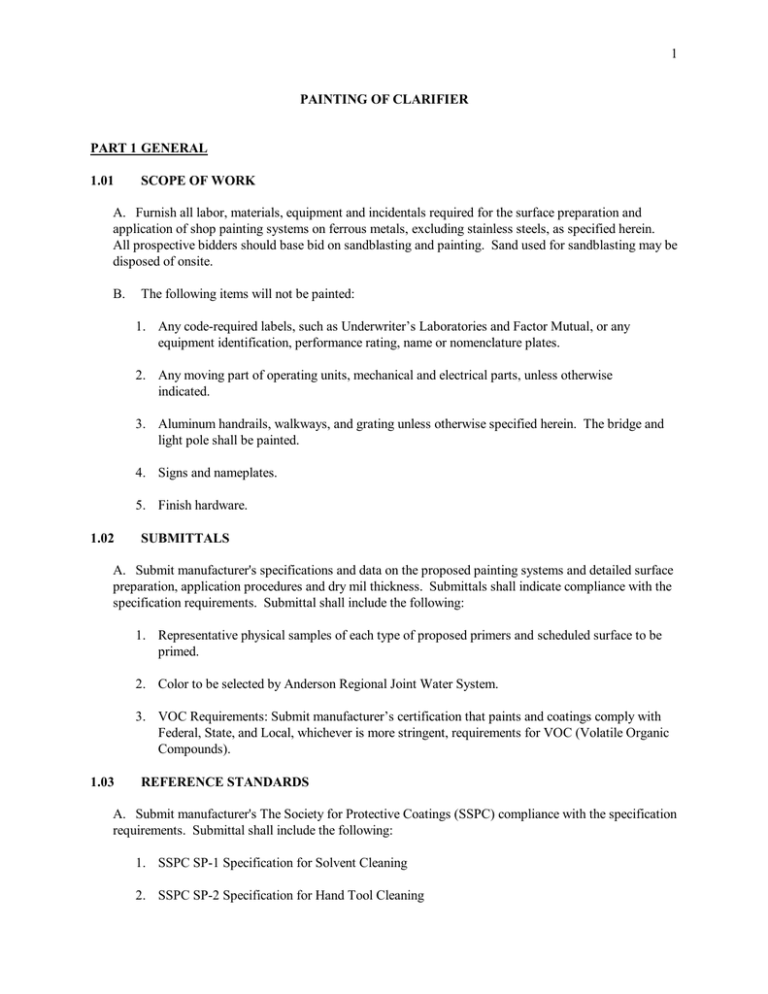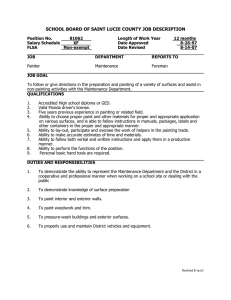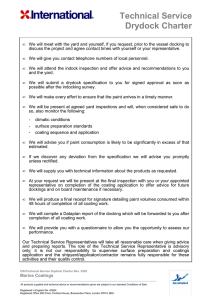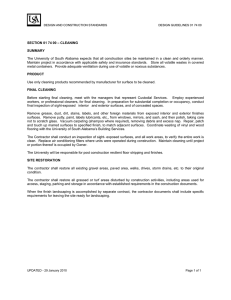Painting Specifications
advertisement

1 PAINTING OF CLARIFIER PART 1 GENERAL 1.01 SCOPE OF WORK A. Furnish all labor, materials, equipment and incidentals required for the surface preparation and application of shop painting systems on ferrous metals, excluding stainless steels, as specified herein. All prospective bidders should base bid on sandblasting and painting. Sand used for sandblasting may be disposed of onsite. B. The following items will not be painted: 1. Any code-required labels, such as Underwriter’s Laboratories and Factor Mutual, or any equipment identification, performance rating, name or nomenclature plates. 2. Any moving part of operating units, mechanical and electrical parts, unless otherwise indicated. 3. Aluminum handrails, walkways, and grating unless otherwise specified herein. The bridge and light pole shall be painted. 4. Signs and nameplates. 5. Finish hardware. 1.02 SUBMITTALS A. Submit manufacturer's specifications and data on the proposed painting systems and detailed surface preparation, application procedures and dry mil thickness. Submittals shall indicate compliance with the specification requirements. Submittal shall include the following: 1. Representative physical samples of each type of proposed primers and scheduled surface to be primed. 2. Color to be selected by Anderson Regional Joint Water System. 3. VOC Requirements: Submit manufacturer’s certification that paints and coatings comply with Federal, State, and Local, whichever is more stringent, requirements for VOC (Volatile Organic Compounds). 1.03 REFERENCE STANDARDS A. Submit manufacturer's The Society for Protective Coatings (SSPC) compliance with the specification requirements. Submittal shall include the following: 1. SSPC SP-1 Specification for Solvent Cleaning 2. SSPC SP-2 Specification for Hand Tool Cleaning 2 3. SSPC SP-3 Specification for Power Tool Cleaning 4. SSPC SP-5 Specification for White Metal Blast Cleaning 5. SSPC SP-6 Specification for Commercial Blast Cleaning 6. SSPC SP-7 Specification for Brush-Off Blast Cleaning 7. SSPC SP-10 Specification for Near White Metal Blast Cleaning 8. SSPC SP-11 Specification for Power Tool Cleaning to Bare Metal 9. SSPC PA-1 Painting Application Specification A. American Society for Testing and Materials (ASTM) 1. ASTM B117 - Standard Practice for Operating Salt Spray (Fog) Apparatus 2. ASTM D3359 - Standard Test Methods for Measuring Adhesion by Tape Test C. D. 1.04 ANSI/NSF Standard 61 for Potable Water Systems. Where reference is made to one of the above standards, the revision in effect at the time of bid opening shall apply. QUALITY ASSURANCE A. Workmanship shall be performed by skilled workmen thoroughly trained in necessary crafts and completely familiar with specific requirements and methods specified herein. B. All materials shall be produced by a single manufacturer. Total paint system shall be from one manufacturer and no cross coating allowed between primers and finish coats. 1.05 DELIVERY, HANDLING AND STORAGE A. Deliver all material to site in original, new, unopened containers, labeled and bearing manufacturer’s name and stock number, product and brand name, contents by volume for major constituents, instruction for mixing and reducing, and application instruction. B. Provide adequate storage facilities designed exclusively for the purpose of paint storage and mixing. Facility area shall be located away from open flames, be well ventilated, and be capable of maintaining ambient storage temperature of no less than 45 degrees F. C. Paint, coatings, reducing agents, and other solvent must be stored in original container until opened: if not resealable, then must be transferred to UL approved safety containers. Provide proper ventilation, personal protection and fire protection for storage and use of same. D. Comply with requirements set forth by Occupational Safety and Health Act for storage and use of painting material and equipment. 3 E. 1.06 Material Safety Data Sheets: A copy of every component’s MSDS shall be available at all times on the Project site. EXTRA STOCK A. Upon completion of work, provide owner with at least one gallon of each type and color of product used. B. Container shall be tightly sealed and clearly labeled for identification. PART 2 PRODUCTS 2.01 ACCEPTABLE SYSTEMS AND MANUFACTURES A. General: Paint product/systems specified are intended to establish a standard of quality desired. 2.02 MATERIALS A. All materials specified herein are manufactured by the Tnemec Company, Inc., North Kansas City, Missouri. PART 3 EXECUTION 3.01 INSPECTION A. Thoroughly examine surface scheduled to be painted prior to commencing work. Report in writing to Anderson Regional Joint Water System any condition that may affect proper application and overall performance of coating system. Do not proceed with work until such conditions have been corrected. Commencing with work indicates acceptance of existing conditions and for responsibility for performance of applied coating. 3.02 PROTECTION A. Extreme diligence shall be taken to ensure that vehicles, equipment, hardware, fixtures, materials, etc. are protected against paint spillage, overspray, etc. Such damages shall be corrected at no expense to Anderson Regional Joint Water System. B. Surfaces not coated shall be masked, removed, or otherwise covered to protect against cleaning and coating application procedures and weather. Drop cloths shall be used to protect floor, walls, machinery, equipment, and previously coated surfaces. C. Exercise care in erecting, bracing, handling, and dismantling staging and scaffolding, to avoid scratching or damaging walls, floors, equipment, etc. 4 3.03 SURFACE PREPARATION A. Perform preparation and cleaning procedures in strict accordance with manufacturer instruction for each substrate condition. B. Ferrous metals (structural steel and miscellaneous metals) requiring painting shall be prepared as listed in “Part 4 Coating System Schedule” specified herein and listed for each individual coating system. All metal surfaces shall be cleaned prior to blast cleaning, if blast cleaning is required, to remove oil and grease present by following methods and procedures outlined in SSPC-SP1 Solvent Cleaning. For submerged Ferrous Metals in potable water, including interior pump surfaces which are in contact with potable water, provide certified NSF Standard 61 products. C. Galvanized metals requiring paint (only as directed by Anderson Regional Joint Water System) shall be cleaned by removing all oil, grease, dirt, dust and other foreign matter by solvent cleaning in accordance with SSPC-SP1 prior to applying any finish. D. Masonry and other previously painted surfaces shall be prepared as listed in “Part 4 Coating System Schedule.” 3.04 APPLICATION A. No paint shall be applied when surrounding air temperature, as measured in the shade, is below 45 degrees F. No paint shall be applied when the temperature of the surface to be painted is below 40 degrees F. Paint shall not be applied to wet or damp surfaces, and shall not be applied in rain, snow, fog or mist, or when the relative humidity exceeds 85%. Paint shall not be applied when the substrate temperature is within 5 degrees of the dewpoint. Paint manufacturer’s temperature guidelines must be followed. B. No paint shall be applied when it is expected that a relative humidity will exceed 85% or that the air temperature will drop below 45 degrees F within 4 hours after the application of the paint. C. Maintain proper ventilation in area of work to alleviate volatile solvents vaporizing from coating materials. D. All ingredients in any container of the coating materials shall be thoroughly mixed and shall be agitated often enough during application to keep the pigment suspended. E. Should thinning be required use only the amount specified by the coating manufacturer. F. Application of coating shall be by brush, roller, mitt, or spray and in accordance with manufacturer recommendations. All material shall be evenly applied to form a smooth, continuous, unbroken coating. Drips, runs, sags, or pinholes shall not be acceptable. G. Provide proper application equipment, including ladders, scaffolding, masking materials, and tools to perform work. Ladders and scaffolding shall meet or exceed UL requirement and Metal Ladder Manufacturers Association. 3.05 SYSTEM INSPECTION AND TESTING 5 A. After application of each coating in the specified system and its surface has cured, measure its thickness with a properly calibrated Nordson Microtest Dry Film Thickness Gauge, or equivalent. Follow standard method for measurement of dry paint thickness with magnetic gauges as outlined in Steel Structures Painting Council’s SSPC-PA2-73T. The Contractor shall furnish a Holiday Detector to determine if the requirements are satisfied. B. Make as many determinations as needed to ensure the specified thickness values in each typical area. To all surfaces having less dry film thickness than specified, apply additional coat(s) at no extra coast to Anderson Regional Joint Water System to bring thickness up to specifications. C. Painting contractor shall permit Owner’s Representative and/or paint and coating manufacturer (as requested by owner) to inspect his work for conformance to this specification. Anderson Regional Joint Water System reserves the right to reject all work, which does not comply with this specification. Where characteristics of coating prohibit recoating, remove and replace unacceptable coating. D. A NACE certified technical representative from the paint manufacturer shall visit the job site to review the work and to support the Contractor's personnel or the Owner as needed and/or requested. Visits shall be made on a weekly basis as a minimum or as needed to review hold points for the Owner. Additional visit shall be made as needed and/or requested by Owner or Contractor. 48 hours’ notice is required by the Contractor for each hold point inspection. 3.06 CLEAN UP A. Upon completion, painting contractor shall clean up and remove from site all surplus materials, tools, appliances, empty cans, cartons, and rubbish resulting from painting work. Site shall be left in neat, orderly condition. B. Remove all protective drop cloths and masking from surfaces not being painted. Provide touch-up around same areas as directed by Anderson Regional Joint Water System. C. Remove all misplaced paint splatters or dripping resulting from this work. 3.07 WARRANTY A. The contractor shall warrant the work free from defects in material and workmanship for a period of one (1) year. The contractor will return within one (1) year and along with an Anderson Regional Joint Water System Representative performs an inspection of the work. Deficiencies found will be corrected by the contractor at no cost to Anderson Regional Joint Water System. PART 4 COATING SYSTEM SCHEDULE 4.01 EXTERIOR SURFACES (Clarifier No. 4 - Flocculators & Clarifier) – Non-Immersion Service A. Structural Steel, Piping, Equipment and all Misc. Metal Surfaces (Non-Immersion) (To include the catwalk and the center column area in non-immersion) Coating System (Existing Surfaces) Surface Preparation: Pressure wash with a minimum pressure of 4000 PSI equipped with a Giant Industries, Inc. Constant Speed Turbo Nozzle as a minimum requirement to remove all loose paint, loose 6 rust, dirt, dust, chalk, mildew, grease, oil and other foreign matter. Follow cleaning with SSPC-SP11 Power Tool to Bare Metal Cleaning to all rusted and abraded areas, feathering the edges of tightly adhered existing paint. Rusted areas must be power tool cleaned or hand sanded at a minimum, to guarantee proper adhesion of primer material and final appearance. Hand wire brushing should be limited to tight and difficult areas primarily. All areas must be clean and dry prior to any coating application. Spot prime all rusted and abraded areas with one coat of Tnemec Series 135 Chembuild at a dry film thickness of 3.0 - 5.0 mils. Follow with two full coats as specified below: 1st Coat: 2nd Coat: 4.02 Series 135 Chembuild Series 73-Color Endura-Shield Dry Film – Mils 4.0-6.0 3.0-5.0 INTERIOR/EXTERIOR SURFACES (Flocculators & Clarifier) – Immersion Service A. Structural Steel, Piping, Equipment and all Misc. Metal Surfaces (Immersion) Coating System (Clarifier Radial Trough, Rake Arm, Center Column, and all steel surfaces in immersion and below the catwalk - New and Existing Surfaces) Surface Preparation: 1st Coat: 2nd Coat: 3rd Coat: SSPC-SP10 Near White Blast Cleaning. Series 1 Omnithane Primer Series 141 Epoxoline Series 141 Epoxoline Dry Film – Mils 2.5-3.5 8.0-10.0 8.0-10.0




